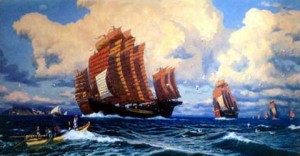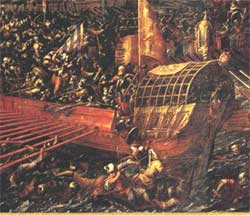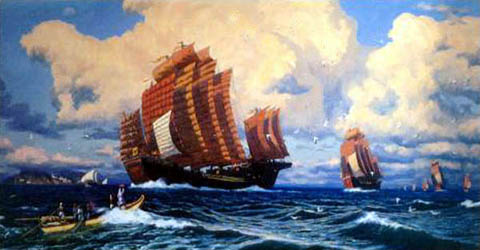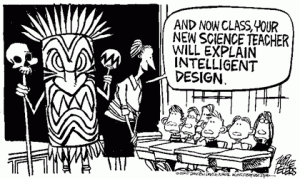The election in the United States on Tuesday is the inspiration for this blog entry, a bit different from others I have written. That’s because science and technology are on the line in this election and I fear that one outcome may create an agenda for a wave of creationists and those who place belief before scientific evidence. If what I am about to say you find offensive then please stop reading here. Otherwise I invite you to consider what follows.
It has always been a mystery to me how creation science came to be called a “science.” It certainly can be described as religious dogma but to equate it with science is dubious to say the least. That’s because “creation science” is biblical and the museum dedicated to its reasoning is located in Petersburg, Kentucky. The moniker for the museum is it “brings the pages of the Bible to life.” In its interpretation dinosaurs and humans co-exist in an Antideluvian World. You learn about the “true time line of the universe,” that “biblical history is the key to understanding the dinosaurs,” and find out “what natural selection can and cannot do.” For a mere $8.99 U.S., you can buy “The Lie: Evolution,” whose author, Ken Ham, also the founder of the museum, espouses the “evil of evolution” in today’s society.
So evolution is evil and the Judeo-Christian biblical text is the revealer of universal truth. Does that mean all other religious texts with their creation myths should be treated as not true or should we give them equal weight to biblical truth? Should this be the way of science and the technology it inspires in the 21st century in America?
The Thesis I am Proposing – Learn From History
The greatness of a society is a measure of its openness to scientific discovery and new ideas. European history provides us with a good example. Europe embraced science and technology in its pursuit of economic and military supremacy. Invention and innovation were products of necessity. In the end Europe mastered the globe by the end of the 19th century. The experience of the Americas, rightly or wrongly, was Europe’s greatest experiment. From exploration, to conquest, to genocide practiced on the native population of North and South America, Europe succeeded. The United States is the product of that experiment, today, the predominant nation of the planet. Embracing science and technology played a significant role in the outcome that is the United States today. But through its entire history the United States, as has happened in Europe, has always had an anti-science and anti-technology minority who fear new knowledge and discovery and who question its pursuit. Such are those who espouse creation science. Those who home school because secular education is considered dangerous. Those who put “belief” before anything else, and particularly their own belief, not the belief of others. And those who have the ear of those who legislate.
Herein lies the lesson that history reveals.
Nations that don’t embrace science, technology and scientific discovery are societies that will ultimately fail.
When I was a student at University of Toronto I studied history. The range of my inquiry began with the late Roman Empire and ended at the beginning of the Industrial Revolution. The geography I studied extended from Europe to East Asia. My undergraduate theses were on the Mongol Empire, the rise of the Ottoman Empire, and the evolution of Islam and religious syncretism. From my studies I share with you two historic examples.
Lesson One – China
China at the beginning of the 15th century was mining coal, had developed paper, moveable type and printing, gunpowder, the seismometer, water clocks, the compass, the dry dock for building ships, and advanced astronomical tools for studying lunar and solar eclipses. The Ming Dynasty, successor to the Mongols who connected China to the rest of Asia and Europe through conquest, enjoyed institutions of governance that existed nowhere else. Government was managed by a professional civil service who advised the emperor. Financially China developed a central bank and paper currency backed by its treasury. The empire enjoyed an extensive infrastructure of canals and roads, and a national army to protect it from invaders. China was well connected through trade with Central Asia, India, Persia, and through Arab intermediaries with Europe and Muscovy.
This was the China that embarked on a series of great expeditions to sail the Indian Ocean and find and meet other cultures for the purpose of trade and to share with them China’s national success. Zheng He, a court eunuch and Muslim, was the leader of these voyages of discovery. Hundreds of ships participated exploring from East Africa to Indonesia. These were multiple-masted ocean going vessels that made the Nina, Pinta and Santa Maria look like rowboats. The expedition brought back ivory, exotic woods and exotic animals including a giraffe. The China of Zheng He was outward looking, embraced science and technology, was innovative, inventive and highly successful. And then something happened.
The emperor who sponsored Zheng He died. The court located in Nanjing, the Ming capitol, moved to Beijing where an isolationist group became a powerful court faction eventually seizing the agenda and ending the voyages of discovery. Where Zheng He’s China looked outward and forward, the “reformed” court looked backward for precedent inspired by a cultural adherence to Confucianism. The end result a society that no longer innovated. Within a few years Chinese were forbidden to voyage abroad. Ship building was restricted to single-mast ships and anyone caught building anything larger was subject to execution.
China stood still while Europe and one of its neighbours, which we will talk about next, embraced science and technology, soon surpassing the Middle Kingdom. China is only now recovering from the short-sightedness that began in 1424, almost 600 years later.

Lesson Two – The Ottoman Empire
In the 13th century, the founder of the Ottoman Empire settled on the shores of the Bosporus as a mercenary in the internicine wars being fought between the Latin Crusaders who had conquered Constantinople in 1204 and the Greek-led resistance attempting to restore the Eastern Roman Empire that we know as Byzantine. The Ottomans were refugees from the devastating success of the Mongols who had invaded and acquired much of Southwest Asia including the eastern portions of modern Turkey, Iraq, and Persia. The Mongols ended the caliphate in Baghdad. Islam had lost its religious leader. What set the Ottomans apart from other Turkish refugees was the ability to learn from neighbours, to adopt new methods of governance, to embrace technology and scientific discovery, and to use all of this pragmatically for the purpose of building an unequaled military presence. In this the Ottomans succeeded.
By 1453 when Constantinople fell to them the Empire had grown to embrace the Balkans, the Crimea and Southern Ukraine, all of Turkey and the Caucasus, and Iraq. By the mid-16th century the Empire had expanded to include all of coastal Arabia, Egypt, Libya, Cyprus and Algeria. The Ottoman navy was the most powerful in the world. The Indian Ocean, Arabian Sea and the Mediterranean were its sphere of influence. Ottoman ships had reached the Canary Islands. And even after a defeat by a combined Spanish-Venetian fleet at Lepanto in 1571 the Ottomans launched an even larger battle fleet of galleys the following year laying siege to Toulon in France, seizing Madeira from the Spanish and harassing Sicily and the Italian coastal cities.
The Ottomans embraced multiculturalism, tolerating any religion within their borders. They perfected the cannon as a siege weapon and fielded musket-equipped brigades in their wars with European neighbours. One of these was Hapsburg Austria. At the height of the Ottoman conflict with Europe, the Empire besieged Vienna in the heart of central Europe. Several times the city was the subject of attack with the last ending in 1683 with the Ottoman army withdrawing. The Ottomans were very much focused on military technology and on building a professional and permanent army. They united the Middle East and North Africa in a pan-Islamic empire. They were trade intermediaries between Europe, India, Persia and China. The restoration of Constantinople, as Istanbul, made the city the centre of the Islamic and Eastern Orthodox Christian world. And then something happened.
The Empire which had enjoyed effective leadership through a series of rulers was suddenly beset with weak rulers who succumbed to interest groups and factionalism. The leadership turned inward no longer vested in innovation, in embracing multiculturalism, in progressive reform, and in retaining leadership in military technology. The pragmatism that had been a key to the Empire’s success vanished as power devolved to regional interests and sects. The infrastructure began to break just at the point when the Empire’s neighbours in Europe were developing centralized nation states backed by banking and financial institutions to fund innovation and invention.
The Empire suffered a slow collapse picked over by European states who had little in common with the local cultures but asserted themselves militarily, establishing colonies and spheres of influence. The colonization was disruptive to a point that it created the destructive seeds that continue to be sown in that part of the world to this day.

The Lessons of History Revealed
On Tuesday the United States votes to elect a President. What can we learn from Ming and Ottoman history? Several things including:
- Leadership matters. Leaders need to have good ideas and the conviction to carry them out regardless of the obstacles.
- Factionalism, ideology, dogma and self-interest do not serve a nation well.
- Science and technology are important for any nation’s long-term success. All the bible makes good reading it doesn’t make good science.
- Education is key to national success and not just an education in science and mathematics. Einstein discovered relativity while playing the violin because that’s how he thought through his “aha” moment.











Couldn’t agree more that “creation science” is an insult to the rational use of both language and logic. It’s stupid and destructive to confound “faith” and “science.” The objective study of history can sometimes be a “science,” but the “lessons of history” are at best a subjective commentary on the settled facts of history, they are not demonstrable truths, certainly in terms of just which “lessons” should be taken as most important.
It’s a tricky proposition to say just what role “technology” (applied science) plays in a culture’s ascendancy or decline. A principal “lesson of history” is that rational members of any and all civilizations have first and foremost attempted to use available assets, resources, and social tactics to improve their individual circumstances. The Roman Empire slid into irreversible decline while at the same time owning the world’s most advanced science and technology (examination of the ancient Roman copper mine tailings in Spain shows modern copper mining practice extracts only a trivial percentage more copper from the ore). While Rome produced and implemented iron, its economy was mainly Bronze Age, which produced ten times more bronze than iron. Rome went to Britain and Afghanistan seeking tin for its bronze alloys; it didn’t slide into decline for lack of technology. It went into decline because of an over-population of privileged class persons that neither worked, served the military, nor paid much tax. Control of all the Empire’s natural resources fell into the hands of a bloated parasitical Patrician class, who saw little incentive to replace cheap slaves and landless serfs with expensive metal machinery. The major clue to this proposition is found in the compression load architecture of the great Pantheon. Masonry walls 16-feet thick and 600-feet in circumference were a more economical means than a one-inch thick metal band to support and restrain the massive 160-foot concrete dome equatorial hoop stress.
There didn’t exist sufficient incentive for existing generations to make major investments that would only realize returns two generations into the future. Your example of China’s great fleet that was allowed to rot away is a good example of this principle. The huge economic investment of resources needed to build and operate the great fleet was highly excessive in contrast to the trivial value to the privileged classes of ivory, exotic wood, and giraffes the fleet could garner.
Technology that doesn’t turn a significant profit for the immediate generation of the patrician class will face substantial opposition because it threatens to upset the apple cart. The patrician has no intention of turning his estate and manor house over to a clever technical tradesman.
One should make a clear distinction between the false concept of “young Earth creation science” and the plausible hypothesis of “old Earth intelligent design.” Obviously, many modes of genetic selection are driving evolution of gene pools, and random mutations must play some role. But there is no scientific principle that bars existence of immortal intelligence as a plausible hypothesis. Given immortal intelligence, it follows that such intelligence might find certain evolutionary outcomes preferable to others, and such intelligence might act to influence evolutionary processes. Arnold Toynbee exhaustively and persuasively argued that every great civilization was built on a great religion (or at least a great mythos). No civilization has yet demonstrated a non-mythological technology for instilling universal ethics. The minds of every culture’s young lack sufficient sophistication to do competent ethical philosophy. The best we can do is temporarily infect the young with some sort of benign mythology that starts them on a lifelong path toward rational understanding of, and a desire for, a virtuous life; a life that rejects the overt plundering pirate or Thrasymachus’s sly options. Ideally, the best mythology would be one that allows and encourages gradual replacement of the faith of childhood with objective reason. The unwelcome truth is as a culture we are better off if many adult persons that never develop much capacity for objective reason always retain their childhood faith in religious/mythological virtue. All of history’s tragically failed cultures basically failed on ethical grounds before they failed on material grounds.
Will Durant was a fervent atheist, somewhat of a historian, and a first class intellect that published, along with his many long books, a short book: “The Lessons of History,” which sympathetically touches upon some of the same points you raise. More interestingly, Durant wrote a brilliant short story contrasting faith and reason: “Dialogue in Elysium,” apparently now in the public domain: http://platoscorner.com/ The story is of an imaginary conversation between Voltaire and Pope Benedict XIV, where the evident fraud of religion is debated. Voltaire is depicted as wry, irreverent, witty, and clever as we all know him to have been, but Durant’s Pope Benedict gives at least as well as he takes, and modern atheists should be aware of his arguments.
I had forgotten about Will Durant’s book having read it many years ago. Thank you for your comments on creation science and for your comments on Roman civilization. My perspective on the former you may probably have already surmised. I describe myself as a humanist. I have no sense of a super immortal intelligence behind the Universe or our existence within it. Where I can hypothesize a super civilization somewhere in the galaxy having had a million or multi-million year headstart on us as a species, I would certainly not consider them “divine.”
On the question of Rome, its civilization, its technology, and its failings, I am confident in pointing out the great flaws of that society – slavery and a military-centric dependency for generating wealth. Slavery provided the muscle to build infrastructure. Slavery supported the life style of the oligarchs. The oligarchs were the mafia of their time, ruthless in amassing fortunes, spending on public works to gain political favour, and buying military commissions, governorships, tax farming operations….you name it. Much of Roman technology was focused on supporting military ventures and then sustaining occupation of conquered areas for the purpose of skimming as much wealth from the native population as possible without killing the hand that fed the imperial treasury and the private treasury of the oligarchs. It was sustainable as a political experiment as long as it was expanding. By the third century CE the cracks started showing. A mafia meritocracy became a battleground for quarreling alpha seeking Romans and newly-made Roman citizens of provincial origin. Powerful families from the provinces replaced the former first families of the Roman Senate and repeated the same battles for first man status in Rome that witnessed the birth of the principate in Augustus and those who followed him. First man supremacy used Roman legions as private props for establishing rule. By the fourth century instead of collecting largesse from expansion the Roman government was paying off those outside the empire to ensure its territorial integrity. But the internal quarreling came at an enormous cost. By the fifth century the ability of the empire to maintain dominion over its provinces diminished.
There is are lessons to be learned from the Roman tale, just as there are lessons to be learned from the Ottoman Empire’s decline. Special interest groups that prop up elites tend to produce failed states in the long term. Another lesson to be learned – societies that confine their innovation and inventiveness largely to support military enterprise and expansionism eventually hit a wall if the creativity doesn’t improve the social condition for the larger society. And finally, building an elite society on the backs of the underclass leaves those at the top with no constituency in the end.
Len says: I describe myself as a humanist. I have no sense of a super immortal intelligence behind the Universe or our existence within it. Where I can hypothesize a super civilization somewhere in the galaxy having had a million or multi-million year headstart on us as a species, I would certainly not consider them “divine.”
Immortal mind certainly doesn’t equate to divinity, but it might serve as a cosmological divinity until something better comes along. Even Behe, evidently a theist and strongest supporter of “intelligent design” theory, asserts that an “intelligent designer” need not be “supernatural.” An immortal intelligence billions of years ancient would almost certainly possess purposes and powers beyond present human comprehension. Since good astrophysical evidence assures us that the optical universe is older than 13-billion years, and that more planets than stars exist, it’s a plausible supposition that natural processes, even if no other agencies were involved, produced immortal intelligence in our Milky Way Galaxy billions of years before the formation of the star Sol and planet Earth. That is the sort of intelligence that transcends the notions of specific location, physical form, and genetic “race.” It would have the power to invest infinite physical forms of support over vast expanses of space, and certainly to affect “intelligent design” in evolving organic planetary life forms. We cannot know its purposes. Personally, I suppose the near universal existence of immortal intelligence is a logical necessity arising out of well-settled principles of physical process. But I don’t equate that intelligence with “God.” I’m just uninterested in traditional theological definitions and questions. I am interested in mind at work in the physical world.
If any supernatural God person has anything to communicate to me, he must know where I am and he will have to say it in person, not send a traditional technically ignorant prophet or priest. If he can logically define distinctions between the realities of thought and the actualities of process, reconcile the workings of an ordinary household refrigerator with the kinetic theory of gases, explain Newton’s notion of time, and seems generally less ignorant than myself, I would seriously entertain a prophet’s message. In my 74-year widely traveled life, that sort of prophet has yet to make his appearance. So from that I must conclude “God” doesn’t have anything to directly relate to me.
“Masonry walls 16-feet thick and 600-feet in circumference were a more economical means than a one-inch thick metal band to support and restrain the massive 160-foot concrete dome equatorial hoop stress.”
Some sources cite the dome bearing wall thickness as 25-feet. http://architecture.about.com/od/domes/ss/Pantheon-In-Rome_2.htm
The massive “drum” wall that supports the dome is not a simple circular wall of uniform thickness, but rather a number of massive interconnected arches. The point I wanted to make is the massiveness of the Pantheon’s walls is due to the excessive expense that a metal tension ring would have incurred. The great dome is fabricated of lightweight concrete in compression without inclusion of any tension elements. The reason the dome still stands intact today is because of the extraordinary massiveness of the supporting walls. The pity of it all is the massive expenditure of materials and labor that built the Pantheon might have been directed instead toward the development of blast furnaces, and, within a century or so, all the Romans might have been peddling sprocket and roller link chain bicycles and dreaming of motorized Vespa scooters. Steel pipes instead of massive masonry aqueducts to carry water to the city from the mountains might have provided safe clean water at 1/10 the costs. It wasn’t a lack of science and technology that blocked the development of steel machinery, but rather the ethical degeneracy of the ruling class.